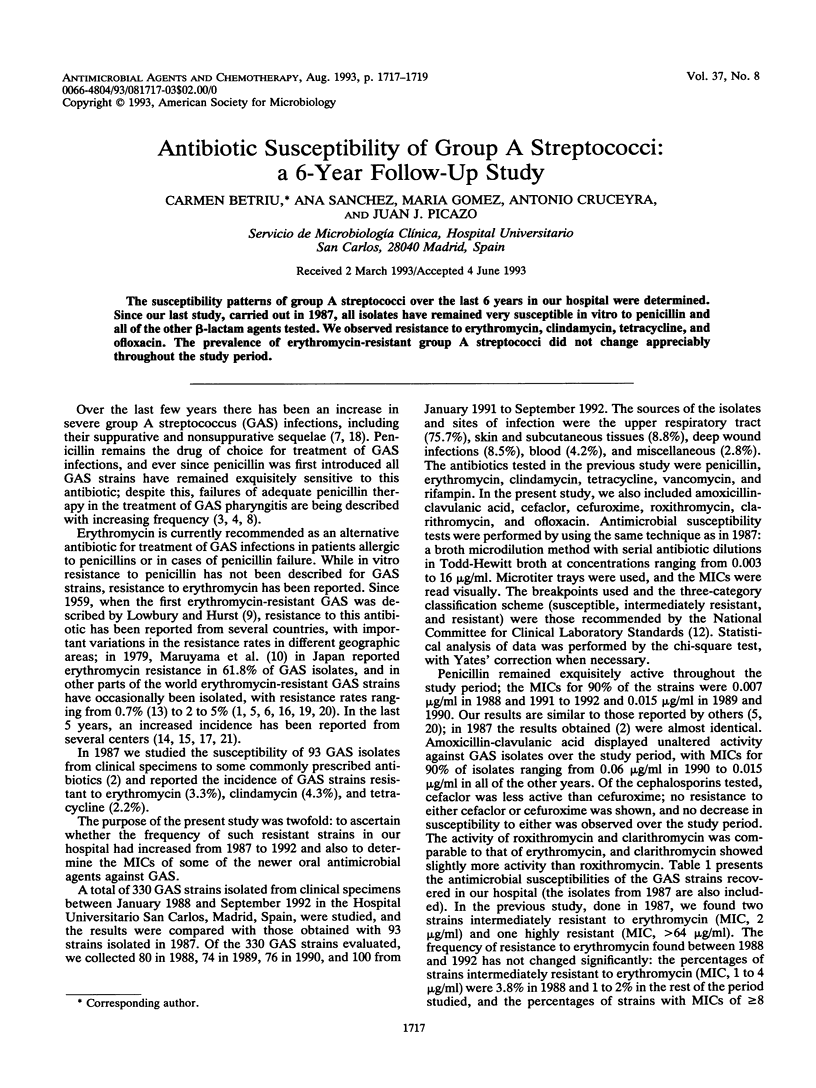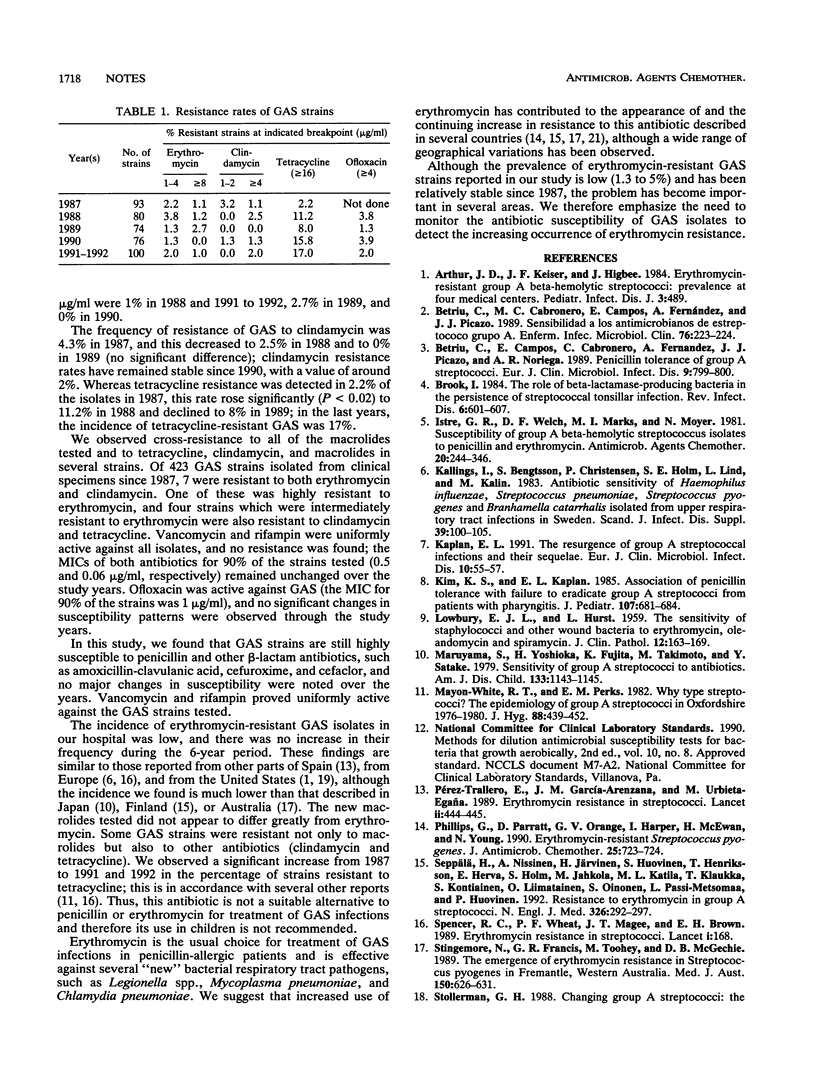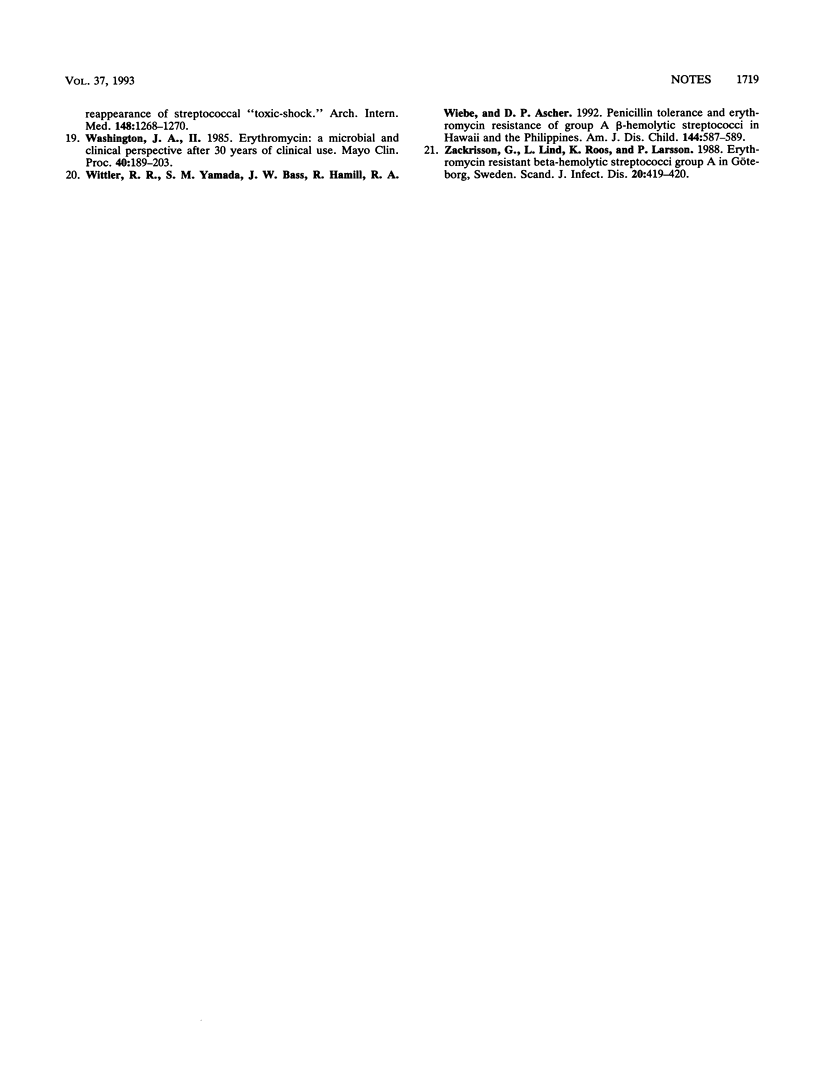Abstract
The susceptibility patterns of group A streptococci over the last 6 years in our hospital were determined. Since our last study, carried out in 1987, all isolates have remained very susceptible in vitro to penicillin and all of the other beta-lactam agents tested. We observed resistance to erythromycin, clindamycin, tetracycline, and ofloxacin. The prevalence of erythromycin-resistant group A streptococci did not change appreciably throughout the study period.
Full text
PDF


Selected References
These references are in PubMed. This may not be the complete list of references from this article.
- Arthur J. D., Keiser J. F., Brown S. L., Higbee J., Butler C. E. Erythromycin-resistant group A beta-hemolytic streptococci: prevalence at four medical centers. Pediatr Infect Dis. 1984 Sep-Oct;3(5):489–489. doi: 10.1097/00006454-198409000-00022. [DOI] [PubMed] [Google Scholar]
- Betriu C., Cabronero M. C., Campos E., Fernández A., Picazo J. J. Sensibilidad a los antimicrobianos de estreptococo grupo A. Enferm Infecc Microbiol Clin. 1989 Apr;7(4):223–224. [PubMed] [Google Scholar]
- Betriu C., Campos E., Cabronero C., Fernandez A., Picazo J. J., Noriega A. R. Penicillin tolerance of group A streptococci. Eur J Clin Microbiol Infect Dis. 1989 Sep;8(9):799–800. doi: 10.1007/BF02185849. [DOI] [PubMed] [Google Scholar]
- Brook I. The role of beta-lactamase-producing bacteria in the persistence of streptococcal tonsillar infection. Rev Infect Dis. 1984 Sep-Oct;6(5):601–607. doi: 10.1093/clinids/6.5.601. [DOI] [PubMed] [Google Scholar]
- Istre G. R., Welch D. F., Marks M. I., Moyer N. Susceptibility of group A beta-hemolytic Streptococcus isolates to penicillin and erythromycin. Antimicrob Agents Chemother. 1981 Aug;20(2):244–246. doi: 10.1128/aac.20.2.244. [DOI] [PMC free article] [PubMed] [Google Scholar]
- Kallings I., Bengtsson S., Christensen P., Holm S. E., Lind L., Kalin M. Antibiotic sensitivity of Haemophilus influenzae, Streptococcus pneumoniae, Streptococcus pyogenes and Branhamella catarrhalis isolated from upper respiratory tract infections in Sweden. Scand J Infect Dis Suppl. 1983;39:100–105. [PubMed] [Google Scholar]
- Kaplan E. L. The resurgence of group A streptococcal infections and their sequelae. Eur J Clin Microbiol Infect Dis. 1991 Feb;10(2):55–57. doi: 10.1007/BF01964407. [DOI] [PubMed] [Google Scholar]
- Kim K. S., Kaplan E. L. Association of penicillin tolerance with failure to eradicate group A streptococci from patients with pharyngitis. J Pediatr. 1985 Nov;107(5):681–684. doi: 10.1016/s0022-3476(85)80392-9. [DOI] [PubMed] [Google Scholar]
- LOWBURY E. J., HURST L. The sensitivity of staphylococci and other wound bacteria to erythromycin, oleandomycin, and spiramycin. J Clin Pathol. 1959 Mar;12(2):163–169. doi: 10.1136/jcp.12.2.163. [DOI] [PMC free article] [PubMed] [Google Scholar]
- Maruyama S., Yoshioka H., Fujita K., Takimoto M., Satake Y. Sensitivity of group A streptococci to antibiotics. Prevalence of resistance to erythromycin in Japan. Am J Dis Child. 1979 Nov;133(11):1143–1145. doi: 10.1001/archpedi.1979.02130110051007. [DOI] [PubMed] [Google Scholar]
- Mayon-White R. T., Perks E. M. Why type streptococci? The epidemiology of group A streptococci in Oxfordshire 1976-1980. J Hyg (Lond) 1982 Jun;88(3):439–452. doi: 10.1017/s0022172400070303. [DOI] [PMC free article] [PubMed] [Google Scholar]
- Perez Trallero E., Garcia Arenzana J. M., Urbieta Egaña M. Erythromycin resistance in streptococci. Lancet. 1989 Aug 19;2(8660):444–445. doi: 10.1016/s0140-6736(89)90618-1. [DOI] [PubMed] [Google Scholar]
- Phillips G., Parratt D., Orange G. V., Harper I., McEwan H., Young N. Erythromycin-resistant Streptococcus pyogenes. J Antimicrob Chemother. 1990 Apr;25(4):723–724. doi: 10.1093/jac/25.4.723. [DOI] [PubMed] [Google Scholar]
- Seppälä H., Nissinen A., Järvinen H., Huovinen S., Henriksson T., Herva E., Holm S. E., Jahkola M., Katila M. L., Klaukka T. Resistance to erythromycin in group A streptococci. N Engl J Med. 1992 Jan 30;326(5):292–297. doi: 10.1056/NEJM199201303260503. [DOI] [PubMed] [Google Scholar]
- Spencer R. C., Wheat P. F., Magee J. T., Brown E. H. Erythromycin resistance in streptococci. Lancet. 1989 Jan 21;1(8630):168–168. doi: 10.1016/s0140-6736(89)91191-4. [DOI] [PubMed] [Google Scholar]
- Stingemore N., Francis G. R., Toohey M., McGechie D. B. The emergence of erythromycin resistance in Streptococcus pyogenes in Fremantle, Western Australia. Med J Aust. 1989 Jun 5;150(11):626-7, 630-1. doi: 10.5694/j.1326-5377.1989.tb136725.x. [DOI] [PubMed] [Google Scholar]
- Stollerman G. H. Changing group A streptococci. The reappearance of streptococcal 'toxic shock'. Arch Intern Med. 1988 Jun;148(6):1268–1270. doi: 10.1001/archinte.148.6.1268. [DOI] [PubMed] [Google Scholar]
- Washington J. A., 2nd, Wilson W. R. Erythromycin: a microbial and clinical perspective after 30 years of clinical use (1). Mayo Clin Proc. 1985 Mar;60(3):189–203. doi: 10.1016/s0025-6196(12)60219-5. [DOI] [PubMed] [Google Scholar]
- Wittler R. R., Yamada S. M., Bass J. W., Hamill R., Wiebe R. A., Ascher D. P. Penicillin tolerance and erythromycin resistance of group A beta-hemolytic streptococci in Hawaii and the Philippines. Am J Dis Child. 1990 May;144(5):587–589. doi: 10.1001/archpedi.1990.02150290081033. [DOI] [PubMed] [Google Scholar]
- Zackrisson G., Lind L., Roos K., Larsson P. Erythromycin-resistant beta-hemolytic streptococci group A in Göteborg, Sweden. Scand J Infect Dis. 1988;20(4):419–420. doi: 10.3109/00365548809032478. [DOI] [PubMed] [Google Scholar]


